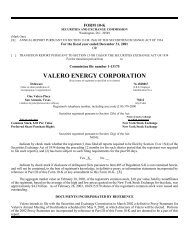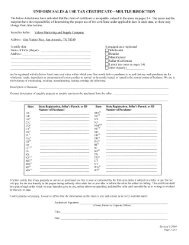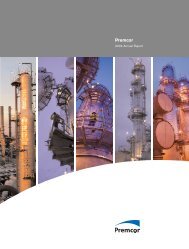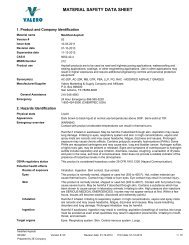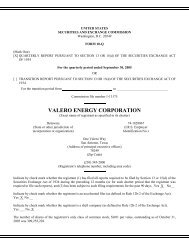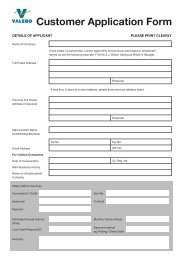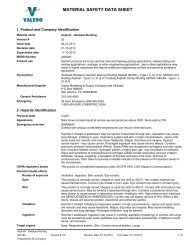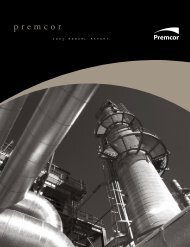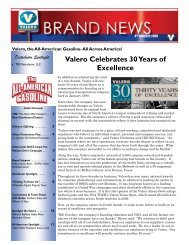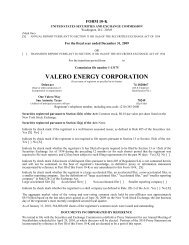Petroleum Coke - Anode Fluid and Fuel Grade - 603 - Valero
Petroleum Coke - Anode Fluid and Fuel Grade - 603 - Valero
Petroleum Coke - Anode Fluid and Fuel Grade - 603 - Valero
- No tags were found...
You also want an ePaper? Increase the reach of your titles
YUMPU automatically turns print PDFs into web optimized ePapers that Google loves.
MATERIAL SAFETY DATA SHEET1. Product <strong>and</strong> Company IdentificationMaterial nameVersion # 03Issue date 03-28-2011Revision date 11-13-2012Supersedes date 09-28-2012CAS # 64741-79-3Product code <strong>603</strong>Product useSynonym(s)Manufacturer/SupplierGeneral Assistance<strong>Petroleum</strong> <strong>Coke</strong> - <strong>Anode</strong>, <strong>Fluid</strong> <strong>and</strong> <strong>Fuel</strong> <strong>Grade</strong>Refinery feedstock.Thermocracked <strong>Petroleum</strong> <strong>Coke</strong>, <strong>Petroleum</strong> <strong>Coke</strong> <strong>Anode</strong> <strong>Grade</strong>, <strong>Petroleum</strong> <strong>Coke</strong> <strong>Fluid</strong> <strong>Grade</strong>,<strong>and</strong> <strong>Petroleum</strong> <strong>Coke</strong> <strong>Fuel</strong> <strong>Grade</strong>See section 16 for complete information.<strong>Valero</strong> Marketing & Supply Company <strong>and</strong> AffiliatesP.O. Box 696000San Antonio, TX 78269-6000210-345-4593Emergency 24 Hour Emergency 866-565-52201-800-424-9300 (CHEMTREC USA)2. Hazards IdentificationPhysical stateAppearanceEmergency overviewOSHA regulatory statusPotential health effectsRoutes of exposureEyesSkinInhalationIngestionSigns <strong>and</strong> symptomsPotential environmental effectsSolid, Liquid.Granular.WARNING!Causes respiratory tract irritation. May form combustible dust concentrations in air (duringprocessing).This product is considered hazardous under 29 CFR 1910.1200 (Hazard Communication).Inhalation.Direct contact with eyes may cause temporary irritation.Prolonged or repeated skin contact may cause drying, cracking, or irritation.Causes respiratory tract irritation.Expected to be a low ingestion hazard.Irritation of nose <strong>and</strong> throat. Respiratory tract irritation. Persons with pre-existing respiratory tract,skin <strong>and</strong> lung (such as asthma) disorders may be aggravated by exposure to this product.Not expected to be harmful to aquatic organisms.3. Composition / Information on IngredientsComponents CAS # Percent<strong>Coke</strong>64741-79-3 1004. First Aid MeasuresFirst aid proceduresEye contactSkin contactInhalationIngestionNotes to physicianAny material that contacts the eye should be washed out immediately with water. If easy to do,remove contact lenses. Get medical attention if symptoms persist.Wash with soap <strong>and</strong> water. Get medical attention if symptoms occur.If symptomatic, move to fresh air. Get medical attention if symptoms persist.Seek medical advice.In case of shortness of breath, give oxygen. Keep victim warm. Keep victim under observation.<strong>Petroleum</strong> <strong>Coke</strong> - <strong>Anode</strong>, <strong>Fluid</strong> <strong>and</strong> <strong>Fuel</strong> <strong>Grade</strong>900668Version #: 03Prepared by 3E CompanyRevison date: 11-13-2012 Print date: 11-13-2012CPH MSDS NA1 / 7
General adviceIf exposed or concerned: get medical attention/advice. Ensure that medical personnel are awareof the material(s) involved, <strong>and</strong> take precautions to protect themselves. Show this safety datasheet to the doctor in attendance. Wash contaminated clothing before re-use.5. Fire Fighting MeasuresFlammable propertiesExtinguishing mediaSuitable extinguishingmediaUnsuitable extinguishingmediaProtection of firefightersSpecific hazards arisingfrom the chemicalProtective equipment <strong>and</strong>precautions for firefightersFire fightingequipment/instructionsSpecific methodsHazardous combustionproductsAvoid generating dust; fine dust dispersed in air in sufficient concentrations, <strong>and</strong> in the presenceof an ignition source is a potential dust explosion hazard.Water spray. Water fog. Dry chemical powder. Carbon dioxide (CO2).Do not use a solid water stream as it may scatter <strong>and</strong> spread fire.High concentrations of dust may form explosive mixture with air.Wear full protective clothing, including helmet, self-contained positive pressure or pressuredem<strong>and</strong> breathing apparatus, protective clothing <strong>and</strong> face mask.Wear full protective clothing, including helmet, self-contained positive pressure or pressuredem<strong>and</strong> breathing apparatus, protective clothing <strong>and</strong> face mask. Fight fire from maximumdistance or use unmanned hose holders or monitor nozzles. Move containers from fire area if youcan do it without risk. In the event of fire, cool tanks with water spray.In the event of fire <strong>and</strong>/or explosion do not breathe fumes.Carbon monoxide. Carbon Dioxide. Nitrogen oxides. Sulfur oxides.6. Accidental Release MeasuresPersonal precautionsEnvironmental precautionsMethods for containmentMethods for cleaning upOther informationKeep unnecessary personnel away. Local authorities should be advised if significant spills cannotbe contained. Keep upwind. Keep out of low areas. Ventilate closed spaces before entering. Donot touch damaged containers or spilled material unless wearing appropriate protective clothing.See Section 8 of the MSDS for Personal Protective Equipment.If facility or operation has an "oil or hazardous substance contingency plan", activate itsprocedures. Stay upwind <strong>and</strong> away from spill. Wear appropriate protective equipment includingrespiratory protection as conditions warrant. Do not enter or stay in area unless monitoringindicates that it is safe to do so. Isolate hazard area <strong>and</strong> restrict entry to emergency crew.Combustible dust. Review Firefighting Measures, Section 5, before proceeding with clean up.Keep all sources of ignition (flames , smoking, flares, etc.) <strong>and</strong> hot surfaces away from release.Contain spill in smallest possible area. Recover as much product as possible (e.g. by vacuuming).Stop leak if it can be done without risk. Spilled material may be absorbed by an appropriateabsorbent, <strong>and</strong> then h<strong>and</strong>led in accordance with environmental regulations. Prevent spilledmaterial from entering sewers, storm drains, other unauthorized treatment or drainage systems<strong>and</strong> natural waterways. Contact fire authorities <strong>and</strong> appropriate federal, state <strong>and</strong> local agencies.If spill of any amount is made into or upon navigable waters, the contiguous zone, or adjoiningshorelines, contact the National Response Center at 1-800-424-8802. For highway or railwaysspills, contact Chemtrec at 1-800-424-9300.Eliminate all ignition sources (no smoking, flares, sparks, or flames in immediate area). Dike thespilled material, where this is possible. Prevent entry into waterways, sewers, basements orconfined areas.Sweep or scoop up <strong>and</strong> remove. Dust deposits should not be allowed to accumulate on surfaces,as these may form an explosive mixture if they are released into the atmosphere in sufficientconcentration. Avoid dispersal of dust in the air (i.e., clearing dust surfaces with compressed air).Nonsparking tools should be used. Clean surface thoroughly to remove residual contamination.This material <strong>and</strong> its container must be disposed of as hazardous waste.Large Spills: Prevent product from entering drains. Do not allow material to contaminate groundwater system. Should not be released into the environment.Clean up in accordance with all applicable regulations.<strong>Petroleum</strong> <strong>Coke</strong> - <strong>Anode</strong>, <strong>Fluid</strong> <strong>and</strong> <strong>Fuel</strong> <strong>Grade</strong>900668Version #: 03Prepared by 3E CompanyRevison date: 11-13-2012 Print date: 11-13-2012CPH MSDS NA2 / 7
7. H<strong>and</strong>ling <strong>and</strong> StorageH<strong>and</strong>lingStorage8. Exposure Controls / Personal ProtectionOccupational exposure limitsACGIHWear personal protective equipment. Do not breathe dust. Avoid contact with eyes, skin, <strong>and</strong>clothing. Do not taste or swallow. Avoid prolonged exposure. Use only with adequate ventilation.Wash thoroughly after h<strong>and</strong>ling. DO NOT h<strong>and</strong>le, store or open near an open flame, sources ofheat or sources of ignition. Protect material from direct sunlight. Take precautionary measuresagainst static discharges. All equipment used when h<strong>and</strong>ling the product must be grounded. Usenon-sparking tools <strong>and</strong> explosion-proof equipment. When using, do not eat, drink or smoke. Avoidrelease to the environment. In the United States of America, refer to NFPA® Pamphlet No. 654,Prevention of Fire <strong>and</strong> Dust Explosions in the Chemical, Dye, Pharmaceutical, <strong>and</strong> PlasticsIndustries."Routine housekeeping should be instituted to ensure that dusts do not accumulate on surfaces.Dry powders can build static electricity charges when subjected to the friction of transfer <strong>and</strong>mixing operations. Provide adequate precautions, such as electrical grounding <strong>and</strong> bonding, orinert atmospheres. Refer to NFPA 654, St<strong>and</strong>ard for the Prevention of Fire <strong>and</strong> Dust Explosionsfrom the Manufacturing, Processing, <strong>and</strong> H<strong>and</strong>ling of Combustible Particulate Solids, for safeh<strong>and</strong>ling. Do not h<strong>and</strong>le or store near an open flame, heat or other sources of ignition. Keepcontainer tightly closed in a cool, well-ventilated place. Keep away from food, drink <strong>and</strong> animalfeedingstuffs. Keep out of the reach of children.Material<strong>Petroleum</strong> <strong>Coke</strong> - <strong>Anode</strong>,<strong>Fluid</strong> <strong>and</strong> <strong>Fuel</strong> <strong>Grade</strong> (CAS64741-79-3)U.S. - OSHAMaterial<strong>Petroleum</strong> <strong>Coke</strong> - <strong>Anode</strong>,<strong>Fluid</strong> <strong>and</strong> <strong>Fuel</strong> <strong>Grade</strong> (CAS64741-79-3)Canada - AlbertaMaterial<strong>Petroleum</strong> <strong>Coke</strong> - <strong>Anode</strong>,<strong>Fluid</strong> <strong>and</strong> <strong>Fuel</strong> <strong>Grade</strong> (CAS64741-79-3)Canada - British ColumbiaMaterial<strong>Petroleum</strong> <strong>Coke</strong> - <strong>Anode</strong>,<strong>Fluid</strong> <strong>and</strong> <strong>Fuel</strong> <strong>Grade</strong> (CAS64741-79-3)Canada - OntarioTypeValueFormTWA 3 mg/m3 Respirable particles.10 mg/m3 Inhalable particles.TypeValueFormTWA 5 mg/m3 Respirable fraction.15 mg/m3 Total dust.TypeValueFormTWA 3 mg/m3 Respirable10 mg/m3 TotalTypeValueFormTWA 3 mg/m3 Respirable fraction.10 mg/m3 Total dust.MaterialType<strong>Petroleum</strong> <strong>Coke</strong> - <strong>Anode</strong>,<strong>Fluid</strong> <strong>and</strong> <strong>Fuel</strong> <strong>Grade</strong> (CAS64741-79-3)TWA 3 mg/m310 mg/m3Respirable.Inhalable particulate.Canada. Ontario OELs. (Control of Exposure to Biological or Chemical Agents)ValueFormComponents<strong>Coke</strong> (CAS 64741-79-3)TypeValueFormTWA 3.5 mg/m3 Total dust.141 mg/m325 ppm<strong>Petroleum</strong> <strong>Coke</strong> - <strong>Anode</strong>, <strong>Fluid</strong> <strong>and</strong> <strong>Fuel</strong> <strong>Grade</strong>900668Version #: 03Prepared by 3E CompanyRevison date: 11-13-2012 Print date: 11-13-2012CPH MSDS NA3 / 7
Canada - QuebecMaterial<strong>Petroleum</strong> <strong>Coke</strong> - <strong>Anode</strong>,<strong>Fluid</strong> <strong>and</strong> <strong>Fuel</strong> <strong>Grade</strong> (CAS64741-79-3)Canada - SaskatchewanMaterial<strong>Petroleum</strong> <strong>Coke</strong> - <strong>Anode</strong>,<strong>Fluid</strong> <strong>and</strong> <strong>Fuel</strong> <strong>Grade</strong> (CAS64741-79-3)Engineering controlsPersonal protective equipmentEye / face protectionSkin protectionRespiratory protectionGeneral hygieneconsiderationsTypeValueFormSTEL 10 mg/m3 Total dust.TypeValueFormTWA 3 mg/m3 Respirable fraction.10 mg/m3 Inhalable fraction.Provide adequate general <strong>and</strong> local exhaust ventilation. Use process enclosures, local exhaustventilation, or other engineering controls to control airborne levels below recommended exposurelimits. It is recommended that all dust control equipment such as local exhaust ventilation <strong>and</strong>material transport systems involved in h<strong>and</strong>ling of this product contain explosion relief vents or anexplosion suppression system or an oxygen deficient environment. Ensure that dust-h<strong>and</strong>lingsystems (such as exhaust ducts, dust collectors, vessels, <strong>and</strong> processing equipment) aredesigned in a manner to prevent the escape of dust into the work area (i.e., there is no leakagefrom the equipment). Use only appropriately classified electrical equipment <strong>and</strong> powered industrialtrucks.Safety glasses.Wear chemical-resistant, impervious gloves. Full body suit <strong>and</strong> boots are recommended whenh<strong>and</strong>ling large volumes or in emergency situations. Flame retardant protective clothing isrecommended.Use a properly fitted, air-purifying or air-fed respirator complying with an approved st<strong>and</strong>ard if arisk assessment indicates this is necessary. Respirator selection must be based on known oranticipated exposure levels, the hazards of the product <strong>and</strong> the safe working limits of the selectedrespirator. If workplace exposure limits for product or components are exceeded, NIOSHapproved equipment should be worn. Proper respirator selection should be determined byadequately trained personnel, based on the contaminants, the degree of potential exposure <strong>and</strong>published respiratory protection factors. This equipment should be available for nonroutine <strong>and</strong>emergency use.Consult supervisor for special h<strong>and</strong>ling instructions. Do not breathe dust. Keep away from food<strong>and</strong> drink. Wash h<strong>and</strong>s before breaks <strong>and</strong> immediately after h<strong>and</strong>ling the product. Provideeyewash station <strong>and</strong> safety shower. H<strong>and</strong>le in accordance with good industrial hygiene <strong>and</strong> safetypractice.9. Physical & Chemical PropertiesAppearancePhysical stateFormColorOdorOdor thresholdpHVapor pressureVapor densityBoiling pointMelting point/Freezing pointSolubility (water)Granular.Solid, Liquid.Powder.Black.Faint.Specific gravity 2.1Flash pointFlammability limits in air,upper, % by volumeFlammability limits in air,lower, % by volumeNot available.Not available.Not applicable.Not applicable.Not applicable.Not available.Insoluble.Not available.Not available.Not available.<strong>Petroleum</strong> <strong>Coke</strong> - <strong>Anode</strong>, <strong>Fluid</strong> <strong>and</strong> <strong>Fuel</strong> <strong>Grade</strong>900668Version #: 03Prepared by 3E CompanyRevison date: 11-13-2012 Print date: 11-13-2012CPH MSDS NA4 / 7
Auto-ignition temperatureEvaporation rateViscosityPartition coefficient(n-octanol/water)Other dataFlammability (solid, gas)Not available.Not applicable.Not applicable.No data available.Combustible dust.10. Chemical Stability & Reactivity InformationChemical stabilityConditions to avoidIncompatible materialsHazardous decompositionproductsPossibility of hazardousreactionsStable under normal temperature conditions <strong>and</strong> recommended use.Heat. Ignition sources. Minimize dust generation <strong>and</strong> accumulation.Strong oxidizing agents.Carbon oxides. Nitrogen oxides. Sulfur oxides. Hydrocarbons.Hazardous polymerization does not occur.11. Toxicological InformationSensitizationAcute effectsChronic effectsCarcinogenicityMutagenicityThis product is not expected to cause skin sensitization.Causes respiratory tract irritation. Dust may irritate the eyes.24 months of exposure in monkeys <strong>and</strong> rats to either 10.2 or 30.7 mg/m3 of coke dust resulted inlung accumulation of dust. There was no associated tissue abnormality in monkeys. A low levelinflammatory response developed in the rat lung at 10.2 mg/m3 <strong>and</strong> more significant inflammatorychanges occurred in the rat lung at 30.7 mg/m3. There was no evidence of carcinogenicity ineither species. Mouse skin painting bioassay negative.This product is not considered to be a carcinogen by IARC, ACGIH, NTP, or OSHA.Ames test: Negative.12. Ecological InformationEcotoxicityPersistence <strong>and</strong> degradabilityBioaccumulation /AccumulationPartition coefficientMobility in environmentalmediaNot expected to be harmful to aquatic organisms.No data available.No data available.No data available.No data available.13. Disposal ConsiderationsDisposal instructionsDispose in accordance with all applicable regulations. Incinerate the material under controlledconditions in an approved incinerator. Do not allow this material to drain into sewers/watersupplies. Do not contaminate ponds, waterways or ditches with chemical or used container.14. Transport InformationDOTNot regulated as a hazardous material by DOT.IATANot regulated as dangerous goods.IMDGNot regulated as dangerous goods.TDGNot regulated as dangerous goods.15. Regulatory InformationUS federal regulationsThis product is a "Hazardous Chemical" as defined by the OSHA Hazard CommunicationSt<strong>and</strong>ard 29 CFR 1910.1200 (OSHA) <strong>and</strong> 8 CCR § 5194 (Cal/OSHA).All components are on the U.S. EPA TSCA Inventory List.<strong>Petroleum</strong> <strong>Coke</strong> - <strong>Anode</strong>, <strong>Fluid</strong> <strong>and</strong> <strong>Fuel</strong> <strong>Grade</strong>900668Version #: 03Prepared by 3E CompanyRevison date: 11-13-2012 Print date: 11-13-2012CPH MSDS NA5 / 7
16. Other InformationOther informationHMIS® ratings Health: 2Flammability: 1Physical hazard: 0NFPA ratings Health: 1Flammability: 1Instability: 0DisclaimerNote: This Material Safety Data Sheet applies to the listed products <strong>and</strong> synonym descriptions forHazard Communication purposes only. Technical Specifications vary greatly depending on theproducts <strong>and</strong> are not reflected in this document. Consult specification sheets for technicalinformation.This Material Safety Data Sheet (MSDS) was prepared in accordance with 29 CFR 1910.1200 by<strong>Valero</strong> Marketing & Supply Co., ("VALERO"). VALERO does not assume any liability arising out ofproduct use by others. The information, recommendations, <strong>and</strong> suggestions presented in thisMSDS are based upon test results <strong>and</strong> data believed to be reliable. The end user of the producthas the responsibility for evaluating the adequacy of the data under the conditions of use,determining the safety, toxicity <strong>and</strong> suitability of the product under these conditions, <strong>and</strong> obtainingadditional or clarifying information where uncertainty exists. No guarantee expressed or implied ismade as to the effects of such use , the results to be obtained, or the safety <strong>and</strong> toxicity of theproduct in any specific application. Furthermore, the information herein is not represented asabsolutely complete, since it is not practicable to provide all the scientific <strong>and</strong> study information inthe format of this document, plus additional information may be necessary under exceptionalconditions of use, or because of applicable laws or government regulations.<strong>Petroleum</strong> <strong>Coke</strong> - <strong>Anode</strong>, <strong>Fluid</strong> <strong>and</strong> <strong>Fuel</strong> <strong>Grade</strong>900668Version #: 03Prepared by 3E CompanyRevison date: 11-13-2012 Print date: 11-13-2012CPH MSDS NA7 / 7





